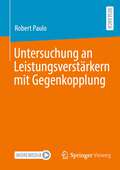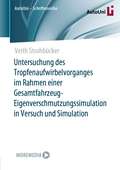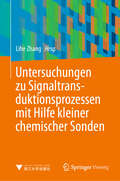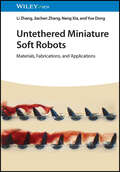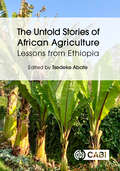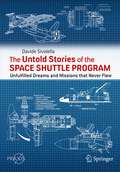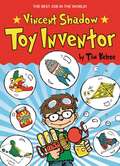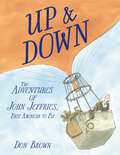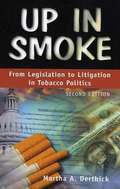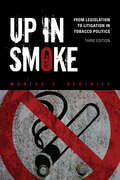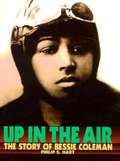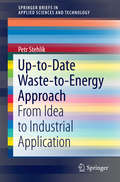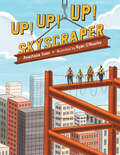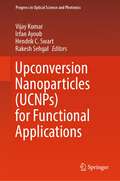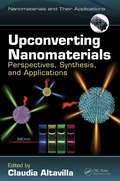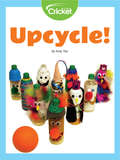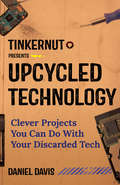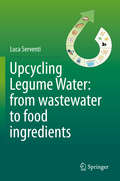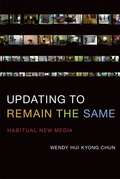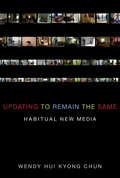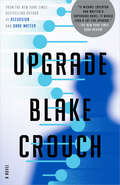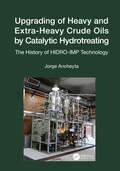- Table View
- List View
Unterrichtsmethoden für MINT-Fächer
by Andreas ZendlerMathematik, Informatik, Naturwissenschaften (Biologie, Chemie, Physik) und Technik - seit Jahren findet in der breiten Öffentlichkeit eine angeregte Diskussion über diese sogenannten MINT-Fächer statt. Denn das in den MINT-Fächern vermittelte Wissen ist die unverzichtbare Grundlage für die Ausbildung der in Deutschland dringend benötigten Fachkräfte. Darum fordern Politik und Wirtschaft eine stärkere Gewichtung der Fächer, aber auch eine Verbesserung der Unterrichtsqualität. Dieses Buch stellt 20 verschiedene, wissenschaftlich fundierte Methoden für den MINT-Unterricht vor und erläutert die Rolle der digitalen Medien als fächerübergreifendes Element. Die interdisziplinäre Betrachtungsweise bietet Lehrern einen umfassenden Überblick über die verschiedenen Möglichkeiten und Ansätze für den eigenen Unterricht. Für jede der vorgestellten Methoden geben die Autoren wissenschaftliche fundierte Einschätzungen zu ihrer Lerneffektivität und erleichtern so Lehrkräften die Auswahl der geeignetsten Methoden für den eigenen Unterricht. Detaillierte Unterrichtsmodelle helfen bei der Umsetzung in der Praxis. Damit erhalten Lehrer und Lehramtsstudenten einen umfassenden Einblick in die effektivsten Unterrichtsmodelle für ein prozess- und ergebnisorientiertes Lernen in den MINT-Fächern. Dieses Buch lässt sich ideal fächerübergreifend einsetzen und dient dazu, die Lerneffektivität speziell im MINT-Unterricht bei Schülerinnen und Schülern zu verbessern.
Untersuchung an Leistungsverstärkern mit Gegenkopplung
by Robert PauloDer in diesem Buch weiterentwickelte Prozess erlaubt eine Optimierung von HF-Leistungsverstärkern zunächst ohne Gegenkopplung mit Hilfe schneller Wechselspannungssimulationen. Ein passendes Parallelnetzwerk, welches verschiedene Parallelgegenkopplungen enthalten kann, wird im Anschluss rein analytisch hinzugefügt. Die Optimierung kann auf Verstärker in einfacher Emitterschaltung, wahlweise mit Kaskodetransistor und mit einer beliebigen Anzahl aufgestapelter Transistoren angewendet werden.Ein weiterer Schwerpunkt ist die Stabilitätsbetrachtung. Es wird gezeigt, wie eine vermaschte Rückführung im Layout eine deutliche Verbesserung der Stabilität bewirkt. Hierfür war eine Erweiterung der klassischen Analyse für die Schleifenverstärkung notwendig.Der Autor führt den Leser durch die analytischen Betrachtungen der einzelnen Schwerpunkte hin zu den simulativen Untersuchungen und verifiziert die Ergebnisse anhand von Messergebnissen gefertigter Verstärkerschaltungen in einer BiCMOS-Technologie. Dem Leser werden zudem beispielhaft sowohl für die Verstärkeroptimierung als auch für die Stabilitätsuntersuchung leistungsstarke Werkzeuge für die Einbettung in eine CAD-Umgebung an die Hand gegeben.
Untersuchung des Tropfenaufwirbelvorganges im Rahmen einer Gesamtfahrzeug-Eigenverschmutzungssimulation in Versuch und Simulation (AutoUni – Schriftenreihe #156)
by Veith StrohbückerIn dieser Arbeit wird im Rahmen einer Fahrzeugeigenverschmutzung eine Untersuchung des Tropfenaufwirbelvorganges an einem Reifen mit numerischen und experimentellen Methoden durchgeführt. Zunächst wird die Tropfenentstehung und das Tropfenfeld eines einzelnen Reifens auf einer wasserbeaufschlagten Rolle in einem Windkanal betrachtet. Anschließend wird über einen neuartigen Ansatz der Tropfenaufwirbelvorgang bei einem einzelnen Reifen direkt simuliert und anhand der erzeugten Versuchsergebnisse validiert. Auf Grundlage des somit entstehenden virtuellen Tropfenfeldes wird eine neue, realistischere Tropfenrandbedingung generiert. Diese neue Randbedingung wird in eine Gesamtfahrzeug-Eigenverschmutzungssimulation implementiert, mit einem klassischen Reifen-Spray-Modell nach dem Stand der Forschung verglichen und realen Verschmutzungsbildern aus Windkanalexperimenten gegenübergestellt.
Untersuchung von Bezugsmaterialkonzepten unter Verwendung nachwachsender Rohstoffe für die Anwendung innerhalb des automobilen Interieurs (AutoUni – Schriftenreihe #173)
by Lars LewerdomskiIn diesem Buch werden drei Bezugsmaterialkonzepte unter Einsatz nachwachsender Rohstoffe untersucht, welche potentielle Alternativen zu konventionell eingesetzten Materialien des Fahrzeuginnenraums darstellen. Die Grundstrukturen bilden ein PVC-Schaumkunstleder, ein Ananasblattfaservliesstoff sowie Flächen bakteriell kultivierter Cellulose. Umgesetzt werden verschiedene Ausführungen der Materialaufbauten mittels labor- sowie großtechnischer Anlagentechnik. Durch die Ermittlung individueller Eigenschaftsprofile nach einer definierten Prüfungsauswahl werden elementare Unterschiede in Abhängigkeit des jeweiligen Ansatzes aufgezeigt und spezifische Optimierungspotentiale für den vorliegenden Anwendungsfall abgeleitet.
Untersuchungen zu Signaltransduktionsprozessen mit Hilfe kleiner chemischer Sonden
by Lihe ZhangIn diesem Buch wird ein umfangreiches Forschungsprogramm zur Erforschung von Signaltransduktionsprozessen mithilfe von Sonden mit kleinen Molekülen vorgestellt. Das Programm wurde von der National Natural Science Foundation of China während des 11. Fünfjahresplans ins Leben gerufen, der im Oktober 2008 begann und Ende 2016 abgeschlossen wurde. Der Bericht fasst zunächst die allgemeinen wissenschaftlichen Ziele und den aktuellen Stand der Signaltransduktionsforschung in China und an der internationalen Grenze zusammen. Basierend auf den neuen Methoden und Technologien, die im Bereich der niedermolekularen Sonden erreicht wurden, veranschaulicht dieses Buch die molekularen Schlüsselereignisse bei Signaltransduktionsprozessen in lebenden Systemen und zeigt die Regulation der Signaltransduktion auf. Dies trägt dazu bei, neue Ideen und Strategien für die Diagnose und Vorbeugung von schweren Krankheiten zu erforschen. Darüber hinaus werden in diesem Buch durch die interdisziplinäre Zusammenarbeit von Biologie und Chemie einige wichtige wissenschaftliche Probleme in der Biologie gelöst und neue Entwicklungen auf diesen Gebieten gefördert. Zu diesen Bereichen gehören die Herstellung von Sonden aus kleinen Molekülen zur Untersuchung der Signaltransduktion und die Entwicklung von Nachweismethoden zur Erfassung von Informationen über die Aktivitäten von Biomakromolekülen. Aufgrund seines Umfangs ist das Buch für Forscher interessant, die in den Bereichen organische Chemie, Naturstoffchemie, medizinische Chemie, analytische Chemie und physikalische Chemie arbeiten. Es fördert auch die multidisziplinäre Zusammenarbeit zwischen Chemie, Medizin, Materialwissenschaft und Biologie.
Untethered Miniature Soft Robots: Materials, Fabrications, and Applications
by Li Zhang Jiachen Zhang Neng Xia Yue DongUntethered Miniature Soft Robots Reference on achieving contactless manipulation of soft robots, detailing high level concepts and perspectives and technical skills of soft robots Untethered Miniature Soft Robots: Materials, Fabrications, and Applications introduces the emerging field of miniature soft robots and summarizes the recent rapid development in the field to date, describing different types of functional materials to build miniature soft robots, such as silicone elastomer, carbon-based materials, hydrogels, liquid crystal polymer, flexible ferrofluid, and liquid metal, and covering the material properties, fabrication strategies, and functionalities in soft robots together with their underlying mechanisms. The book discusses magnetically, thermally, optically, and chemically actuated soft robots in depth, explores the many specific applications of miniature soft robots in biomedical, environmental, and electrical fields and summarizes the development of miniature soft robots based on soft matter, fabrication strategies, locomotion principles, sensing and actuation mechanisms. In closing, the text summarizes the opportunities and challenges faced by miniature soft robots, providing expert insight into the possible futures of this field. Written by four highly qualified academics, Untethered Miniature Soft Robots covers sample topics such as: Soft elastomer-based robots with programmable magnetization profiles and untethered soft robots based on template-aiding Working mechanisms of carbon-based materials, covering light-induced expansion and shrinkage, and humidity-induced deformation Designing microscale building blocks, modular assembly of building blocks based on Denavit-Hartenberg (DH) matrix, and inverse and forward design of modular morphing systems Material designs of magnetic liquid crystal elastomers (LCE) systems, multiple-stimuli responsiveness of magnetic LCE systems, and adaptive locomotion of magnetic LCE-based robots Controllable deformation and motion behaviors, as well as applications of ferrofluids droplet robots (FDRs), including cargo capturing, object sorting, liquid pumping/mixing, and liquid skin. Providing highly detailed and up-to-date coverage of the topic, Untethered Miniature Soft Robots serves as an invaluable and highly comprehensive reference for researchers working in this promising field across a variety of disciplines, including materials scientists, mechanical and electronics engineers, polymer chemists, and biochemists.
The Untold Stories of African Agriculture: Lessons from Ethiopia
by Melaku Admasu Seid Ahmed Kemal Getinet Alemaw Dessie Ambaw Gashawbeza Ayalew Workneh Ayalew Dr Amsalu Ayana Ashenafi Ayano Ferdu Azerefegne Endashaw Bekele Getachew Belay Terefe Belehu Mintewab Bezabih Asmare Dagnew Maru Degefa Mulat Demeke Minyahel Fekadu Daneal Fekersillassie Regassa Feyissa Asnake Fikre Messele Fisseha Amare Fufa Muluken Goftishu Endeshaw Habte Konjit Hailu Karta Karke Kalsa Girma Tesfahun Kassie Friew Kelemu Tolera Keno Rahwa Kidane Berga Lemaga Abebe Menkir Takele Negewo Hawani Negussie Mesfin Shenkut Amare Tegbaru Kindie Tesfaye Taye Tessema Melaku Wale Wondimagegnehu Mersie Zerihun Yemataw Firehun Yirefu Mikael Fisseha Yohannes Engida Zemedagegnehu Olubunmi A. BosseyThis landmark volume presents the results of a comprehensive and coherent in-depth assessment of Ethiopian agriculture and draws lessons from it to generate actionable recommendations that will inform policy decisions and priority setting for agricultural transformation across Africa. Policy makers in Africa are faced with the challenges of ensuring food and nutrition security and the economic wellbeing of their rapidly growing populations while at the same time maintaining the integrity of their natural resource base. Between 2000 and 2021, 74% of the growth in overall crop production on the continent was derived from increases in land area expansion, while increases in yield contributed only 26% of the growth. This unchecked expansion of land use puts the sustainability of the natural resource base under severe pressure. Even though some countries have made substantial increases in their farm productivity over the last two decades, the overall performance for Africa is far behind other regions. For the most part, in Africa, agriculture is not fulfilling its expected functions of food and nutrition security, increased export earnings, import substitution, and raw material supply for local industries. Attempts have been made to transform African agriculture over the years, but few countries have succeeded in achieving sustainable change. Using examples from Ethiopia this book identifies the major factors for success and the root causes of underperformance, and offers evidence-based recommendations for future decision making, policy change and the creation of growth. This book: · Draws on a unique set of case studies from Ethiopia described and told from a truly African perspective. · Emphasises to policy makers in Africa that development cannot be outsourced and there are no shortcuts; it is only through consistent effort and sustained support for their agricultural research and development that positive change can be brought about. · States that past agricultural development efforts by the international community have not properly included a strong African voice, and that therefore, all future academic research, policies and strategies dealing with the continent's agriculture and food security should be formulated by Africa's own leading thinkers and experts. · Is not a polemic; its arguments are knowledge and evidence based, building a compelling picture of how agricultural development can be sustained for the future.
The Untold Stories of the Space Shuttle Program: Unfulfilled Dreams and Missions that Never Flew (Springer Praxis Books)
by Davide SivolellaIn September 1969, several months after the Apollo 11 lunar landing, President Richard M. Nixon established the Space Task Force to chart NASA’s path for the decades to come. This imaginative vision was shattered less than six months later when, on January 13, 1970, NASA Administrator Dr. Thomas Paine announced that, owing to funding cuts, only the reusable Space Shuttle could be afforded -- there would be no space station, no return to the Moon, and no missions to Mars. This is a story never before told about the missions and technologies that NASA had begun to plan but never fully realized. The book is a companion to the author’s previous two works on the Space Shuttle. Whereas the first two books showed how the Space Shuttle flew in space and what the program accomplished, this book explains what more the Space Shuttle could have achieved and how the space transportation system could have further matured if circumstances had been otherwise. A final chapter also discusses how some of these plans might be resurrected in future programs.
The Unusual Mind of Vincent Shadow (Vincent Shadow #1)
by Tim KehoeVincent Shadow isn't particularly good at sports and is constantly being picked on by his classmates at Central Middle School. But it is Vincent's unusually creative mind that truly separates him from other kids his age. Vincent's top secret attic lab is crammed with toy prototypes --from Liquid Superballs to Bullz-I Basketballs and Sonic Snorkelz--and he has a sketch book filled with drawings of toys he still wants to build. So when a chance encounter with an eccentric toy inventor offers him the opportunity to go from unknown weird kid to toy inventor extraordinaire, Vincent realizes that playtime is over: it's time to get serious about toys.
Up & Down: The Adventures of John Jeffries, First American to Fly
by Don BrownThe incomparable Don Brown chronicles the ballooning misadventures of John Jeffries, scientist and aviation pioneer.Swept up by the European ballooning craze of the 1780s, Dr. John Jeffries longed to become the first person to fly across the English Channel. But first he had to outwit a rascally copilot, keep the balloon from bursting, and avoid crashing into the sea. The good doctor's quick-thinking solutions will surprise young readers--and keep them giggling. Orbis Pictus and Sibert Honor winner Don Brown tells this quirky true story with his usual accuracy and heart.
Up in Smoke: From Legislation to Litigation in Tobacco Politics
by Martha A. DerthickMartha Derthick introduces new evidence from 5 years under the MSA to show that the states were more interested in raising revenue than in improving tobacco control, that the enrichment of wealthy tort lawyers violated the legal profession's ethics.
Up in Smoke: From Legislation to Litigation in Tobacco Politics
by Martha A. DerthickNow, with a brand new 3rd edition, the book returns to "ordinary politics" and the passage of the Family Smoking Prevention and Tobacco Control Act which gave the FDA broad authority to regulate both the manufacture and marketing of tobacco products. Derthick shows our political institutions working as they should, even if slowly, with partisanship and interest group activity playing their part in putting restraints on cigarette smoking.
Up in the Air: The Story of Bessie Coleman
by Philip S. HartPresents the story of Bessie Coleman, an American, who in 1920 traveled to France to become the first black woman to earn a pilot's license.
Up-to-Date Waste-to-Energy Approach
by Petr StehlikPutting forward an up-to-date waste-to-energy approach that combines experience, sophisticated modeling and technical-economic analysis, this book examines the current need for the maximum utilization of energy from waste and the associated environmental impacts. It outlines step-by-step procedures for a complex and original waste-to-energy approach from the idea to its industrial application. With waste incinerators and industrial plants producing large amounts of pollutants, municipalities as well as smaller decentralized operations are beginning to focus on waste research. The principal advantage of utilizing research findings is the ability to apply a complex approach "from idea to industrial implementation" with respect to the needs of the market established by thorough market analysis. This book builds on this concept with an original approach that takes into consideration geographical aspects, the specifics of regions/micro-regions and technological units and/or equipment. Key areas discussed and analyzed in the text include: strategic planning of energy-source locations according to the nature of the respective region or microregion; types and amounts of wastes; logistics etc. using original mathematical models; consideration of on-site processing of various types of waste, taking into account the character of the region (agricultural, industrial etc. ); tailor-made technologies for energy recovery from various types of wastes; implementation of individual technologies with original elements; and support for environmental protection based on advanced flue gas (i. e. off-gas in the case of incineration) cleaning methods.
Up! Up! Up! Skyscraper
by Anastasia SuenSnappy rhymes invite young readers to watch workers dig, pour, pound, and bolt a skyscraper into existence. Simple yet satisfying sidebars provide further information about each step in the construction process. Perfect for preschoolers and all those who dig diggers.Quirky, colorful art enhance the appeal of a construction site with all the equipment and sounds of building.
Up Your Teaching Game: Creating Story-Based Games to Engage K-12 Students
by Janna Jackson KellingerUp Your Teaching Game offers K-12 teachers an intuitive and refreshingly fun pathway for creating immersive, story-based games that encourage students to experience the curriculum through play. Regardless of their technical abilities, design acumen, grade level, or domain, today’s teachers have fresh opportunities to create and implement their own content-based games based on the same techniques that video game designers use to create commercial video games. In five actionable steps, this book prepares educators to design curricular games that teach instead of test, that are derived from content rather than divergent from it, and that motivate students to take ownership over their learning. Programs that most teachers are familiar with, such as PowerPoint and Google Slides, and technologies that may be new to them, such as Twine and Scratch, are addressed alongside the use of their own classrooms and schools as game spaces. Novice and veteran teachers alike, as well as curriculum designers and school technologists, will find a wealth of strategies and lessons learned, tips for avoiding pitfalls and time constraints, examples of quests and storyline advancement, and much more.
Upconversion Nanoparticles (Progress in Optical Science and Photonics #24)
by Vijay Kumar Irfan Ayoub Hendrik C. Swart Rakesh SehgalThis book explores upconversion nanoparticles (UCNPs) at both, the fundamental as well as applied levels, for functional applications. It provides a broad perspective about the synthesis approaches of UCNPs with the preferred size, improved and tunable upconversion luminescence, along with the combined multifunctionality for various applications. It highlights the fundamentals and systematic developments in the tuning of UC emission and surface engineering of UCNPs that make UCNPs convenient for use in a large range of applications. Moreover, it gives an understanding of the imposed limitations and challenges associated with these methods to achieve the desired performance in targeted applications. It also includes the latest multifunctional lanthanide-based UCNPs, which efficiently convert low-energy photons into high-energy photons, and their applications in fluorescent microscopy, deep-tissue bioimaging, nanomedicine, optogenetics, solid-state lighting, solar cells, security labeling, and volumetric display.
Upconverting Nanomaterials: Perspectives, Synthesis, and Applications (Nanomaterials and their Applications)
by Claudia AltavillaUpconverting Nanomaterials: Perspectives, Synthesis, and Applications serves as a powerful instrument that explores cutting-edge research knowledge on the topic of upconverting nanosystems, while simultaneously providing the necessary fundamental background for nonspecialist readers. The various aspects of upconverting materials are approached both from a theoretical point of view, particularly upconverting phenomenon, and a practical one. By presenting synthetic strategies, functionalization, production of core shell structures and nanocomposites, this book supplies PhD students, researchers, and scientists with a wealth of ideas they can apply to different fields of research. Thirty-five renowned scientists from around the world have collaborated to produce 11 chapters that help to "make a voyage" through the most important aspects of UPNPs, including syntheses, mechanism, functionalization, and applications.
Upcycle!
by Amy TaoGot a pair of old tights, an empty can or a plastic bottle that you plan to throw away? You can upcycle those old things and turn them into new items you can use! Upcycling is recycling in a better way! Learn how to make a decorative pencil holder, a draft dodger to keep the cold out, or turn plastic bottles into bowling pins. What things can you create to reduce the use of plastic and metal?
Upcycled Technology: Clever Projects You Can Do With Your Discarded Tech (Tinkernut)
by Daniel T. DavisDIY science projects using old tech to create new zombie tech—an eco-friendly, fantastic way to learn about today&’s technology. We all have a drawer or closet full of old discarded tech just sitting around, gathering dust. Memories of a bygone technological era that have been replaced by newer, shiner, smarter devices. What can you do with them? Most of us don&’t even know how to properly dispose of them. If only there was a way to save them from their untimely fate. Well empty out that drawer and grab a screwdriver because the time has come to bring these old devices back from the grave! Old technology may no longer be useful, but it isn&’t useless. Hidden inside often-discarded devices is a treasure trove of motors, magnets, screens, and other parts just waiting for a chance to be upcycled! And this type of &“upcycling&” doesn&’t mean turning an old CD into a coaster, it means something a little more hardcore, like . . . · How to make a great Wi-Fi security camera with an old cell phone · How to make a basic 3D printer out of old computer disk drives · What can be made with the rare-earth magnets inside old hard drives or the reusable LCD screens in old phones · And much more Fans of Popular Science, Smithsonian&’s Maker Lab, and The Big Book of Makerspace Projects will love Upcycled Technology.
Upcycling Legume Water: from wastewater to food ingredients
by Luca ServentiFood manufacturing generates an incredibly high volume of wastewater. The legume industry is one of the top contributors to this environmental issue, as soaking and boiling are necessary to transform dried legumes into cooked canned products and other legume-based products, such as soymilk, tofu, hummus and flours. Wastewater must be treated prior to disposal into the environment, thus raising production costs for the food industry. In addition, wastewater contains nutrients that are lost from the food chain after disposal. As water and soluble nutrients are becoming a limited resource, it is critical to optimize food manufacturing at all levels. Recycling Legume Wastewater Into Food Ingredients presents a sustainable solution to this increasing demand for food and water. The text analyses the composition of legume wastewater and its physicochemical properties, including its potential applications in emulsifiers, foaming agents, gelling agents and antistaling ingredients. Early chapters discuss the processing of legumes and the wastewater generation involved. Further sections focus on wastewater generated by soaking and cooking, including the composition, functional properties, and food applications involved in each. Sprouting water, bioactives and applications in edible packaging are also discussed. In presenting a sustainable solution for legume wastewater use, this text is an important key to sustainability in food processing and the reduction of waste.
Updating to Remain the Same: Habitual New Media
by Wendy Hui ChunNew media -- we are told -- exist at the bleeding edge of obsolescence. We thus forever try to catch up, updating to remain the same. Meanwhile, analytic, creative, and commercial efforts focus exclusively on the next big thing: figuring out what will spread and who will spread it the fastest. But what do we miss in this constant push to the future? In Updating to Remain the Same, Wendy Hui Kyong Chun suggests another approach, arguing that our media matter most when they seem not to matter at all -- when they have moved from "new" to habitual. Smart phones, for example, no longer amaze, but they increasingly structure and monitor our lives. Through habits, Chun says, new media become embedded in our lives -- indeed, we become our machines: we stream, update, capture, upload, link, save, trash, and troll. Chun links habits to the rise of networks as the defining concept of our era. Networks have been central to the emergence of neoliberalism, replacing "society" with groupings of individuals and connectable "YOUS." (For isn't "new media" actually "NYOU media"?) Habit is central to the inversion of privacy and publicity that drives neoliberalism and networks. Why do we view our networked devices as "personal" when they are so chatty and promiscuous? What would happen, Chun asks, if, rather than pushing for privacy that is no privacy, we demanded public rights -- the right to be exposed, to take risks and to be in public and not be attacked?
Updating to Remain the Same: Habitual New Media
by Wendy Hui ChunWhat it means when media moves from the new to the habitual—when our bodies become archives of supposedly obsolescent media, streaming, updating, sharing, saving. New media—we are told—exist at the bleeding edge of obsolescence. We thus forever try to catch up, updating to remain the same. Meanwhile, analytic, creative, and commercial efforts focus exclusively on the next big thing: figuring out what will spread and who will spread it the fastest. But what do we miss in this constant push to the future? In Updating to Remain the Same, Wendy Hui Kyong Chun suggests another approach, arguing that our media matter most when they seem not to matter at all—when they have moved from “new” to habitual. Smart phones, for example, no longer amaze, but they increasingly structure and monitor our lives. Through habits, Chun says, new media become embedded in our lives—indeed, we become our machines: we stream, update, capture, upload, link, save, trash, and troll.Chun links habits to the rise of networks as the defining concept of our era. Networks have been central to the emergence of neoliberalism, replacing “society” with groupings of individuals and connectable “YOUS.” (For isn't “new media” actually “NYOU media”?) Habit is central to the inversion of privacy and publicity that drives neoliberalism and networks. Why do we view our networked devices as “personal” when they are so chatty and promiscuous? What would happen, Chun asks, if, rather than pushing for privacy that is no privacy, we demanded public rights—the right to be exposed, to take risks and to be in public and not be attacked?
Upgrade: A Novel
by Blake CrouchThe mind-blowing new thriller from the New York Times bestselling author of Dark Matter and Recursion. <p><p>“You are the next step in human evolution.” <p><p>At first, Logan Ramsay isn’t sure if anything’s different. He just feels a little . . . sharper. Better able to concentrate. Better at multitasking. Reading a bit faster, memorizing better, needing less sleep. But before long, he can’t deny it: Something’s happening to his brain. To his body. He’s starting to see the world, and those around him—even those he loves most—in whole new ways. <p><p>The truth is, Logan’s genome has been hacked. And there’s a reason he’s been targeted for this upgrade. A reason that goes back decades to the darkest part of his past, and a horrific family legacy. Worse still, what's happening to him is just the first step in a much larger plan, one that will inflict the same changes on humanity at large—at a terrifying cost. <p><p>Because of his new abilities, Logan’s the one person in the world capable of stopping what’s been set in motion. But to have a chance at winning this war, he’ll have to become something other than himself. Maybe even something other than human. <p><p>And even as he’s fighting, he can’t help wondering: what if humanity’s only hope for a future really does lie in engineering our own evolution? <p><p>Intimate in scale yet epic in scope, Upgrade is an intricately plotted, lightning-fast tale that charts one man’s thrilling transformation, even as it asks us to ponder the limits of our humanity—and our boundless potential. <p> <b>New York Times Bestseller</b>
Upgrading of Heavy and Extra-Heavy Crude Oils by Catalytic Hydrotreating: The History of HIDRO-IMP Technology
by Jorge AncheytaThis book explores the common approaches to upgrade heavy and extra-heavy crude oils by means of catalytic hydrotreating, emphasizing hydrogen addition technology as well as carbon rejection alternatives. Kinetic and reactor models are combined with experimental data to simulate and optimize commercial-scale reactor performance. Key Features• Focuses on fixed-bed catalytic hydrotreating and catalysts and process scheme characteristics for commercial application.• Guides readers on hydrotreating process technology development from batch reactor experiments to semi-commercial test.• Describes step-by-step methodologies for development of kinetic models based on experimental data generated at different reaction scales.• Provides detailed explanation on how to formulate a reactor model for the simulation of catalytic hydrotreating of heavy oils. A comprehensive guide to the upgrading of crude oils, this book has particular appeal for petroleum refining industry professionals, catalyst developers, workshop instructors, professors, and their graduate and postgraduate students.

